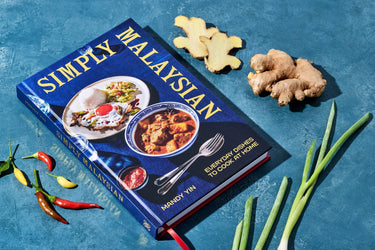5 Things We Learned From "Simply Malaysian" by Mandy Yin
Welcome back to Cookbook Club! Every month or so we feature a new-to-us book we love. (Are you following our HexClad recipes Insta? Find links to new book picks there.) Recently we've examined some tasty plant-based cuisine and gone deep on barbecue. This time, we're exploring Malaysian cuisine.
Mandy Yin didn’t start out wanting to be a chef. After moving from Malaysia to London when she was 11, she eventually became a successful corporate lawyer. Working insane hours and facing burnout, she started to ponder her passion in life.
The answer? Food. Having grown up with a mom (or "mum," if you ask Mandy) who was a fantastic cook, Mandy was no stranger to excellent Malaysian food.
“Back then, 12 years ago, Malaysian food was severely underrepresented in London. There were maybe a handful of Malaysian restaurants,” she says.
Cut to her opening a street food stall featuring a chicken satay burger. The “magic” London street food scene helped snag a clientele who were hoping for her to open a brick-and-mortar location. That led to Sambal Shiok, her laksa bar in the Highbury neighborhood of London.
After publishing her first cookbook, which focused on the project-style recipes the restaurant is known for, Mandy’s life turned upside-down. Just two weeks after publication, her son was born, and she navigated the challenges of childcare, running a restaurant and getting dinner on the table all at once. Simply Malaysian, her second cookbook, is the result of these past few years. Everyday, doable dishes became crucial, especially ones that her husband could make (case in point: her super-simple but flavorful Salmon With Ginger, Honey and Chile).

“It became clear when I was writing this book that there would be no snacks and no desserts. And the recipes would be as economical as possible. It’s how I’ve been cooking for the last nearly four years,” she says.
Here's what we learned from Mandy's incredible cookbook.
1. Malaysian Food Is Everyday Food
Yes, there are a lot of tips and tricks for making delicious dishes in Mandy’s book, but perhaps the most important thing to learn for anyone unfamiliar with Malaysian cooking is how doable these meals are. With a “pared-back approach to cooking,” and taking inspiration from Malaysian economy rice stalls (rice-centric buffets), Mandy makes the case that the flavorful and colorful food of her childhood country is something that anyone can make on a daily basis. There’s also the fact of cost: In the book’s introduction, she notes that “these recipes also happen to be very affordable, too.”
2. A Well-Stocked Pantry Is Essential
One of Mandy’s goals in writing the book was to showcase how much great Malaysian cooking can be made with readily available staples. You might be surprised how many you already have in your pantry, such as chiles, coconut milk, dried spices, curry powder, soy sauce, sesame oil, fish sauce, oyster sauce, rice vinegar, Thai red curry paste, ketchup and tamarind paste. For slightly deeper cuts, add shrimp paste, yellow bean sauce, dried shrimp and dried Chinese mushrooms to your shopping list.
3. Combos Are Key
“We like variety in Malaysian cuisine,” says Mandy. The goal? That your mouth doesn’t get bored. She adds, “In Malaysia, it is possible to eat a different meal for breakfast, lunch and dinner for an entire year.”
That’s the spirit that influenced the menus at the front of the book, which offer pairing suggestions for the dishes to follow. Mandy was eager to point out that it’s not a "table of contents" page but rather a place from which to draw inspiration. Texture is important enough to deserve its own menu, while proteins and veg are combined based on levels of heat.
“We like dry combined with wet, spicy with not spicy," Mandy says.

4. Pro Tip: Shallot Oil
There are only four recipes in the homemade must-haves chapter at the front of the book. Shallot oil—a simple combination of shallots fried in oil—is used five times in the book, from as a topping for congee to a garnish on silken tofu or on top of Beef and Tomato Rice for a flavorful one-pot dinner.
5. Consider "Velveting"
“In Malaysian cooking, we don’t just have a 200-gram (about 7 ounces) portion to oneself,” Mandy says.
Instead, she says, a smaller amount of inexpensive beef will be cut up and used in a dish like Black Pepper Beef. One of the ways to make that modest amount of meat feel more generous is to “velvet” the meat by adding cornstarch to the seasoning mixture, which tenderizes the meat. Other techniques include using smaller pieces of meat and adding vegetables to the mix to make each serving feel more generous.
At the end of the day, what’s most important to Mandy is that cooks realize that this is food for them.
“If you’re familiar or comfortable with with stir-frying or roasting or braising or sautéing, Malaysian food is absolutely for you," she says.
Ready to explore some exciting new flavors? Try your hand at Mandy's Salmon With Ginger, Honey and Chile and grab yourself a copy of Simply Malaysian.
*Quotes have been edited and condensed for clarity.






